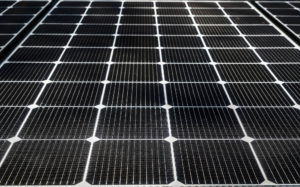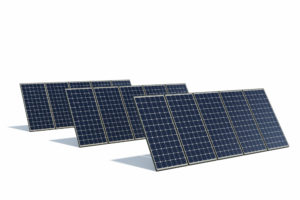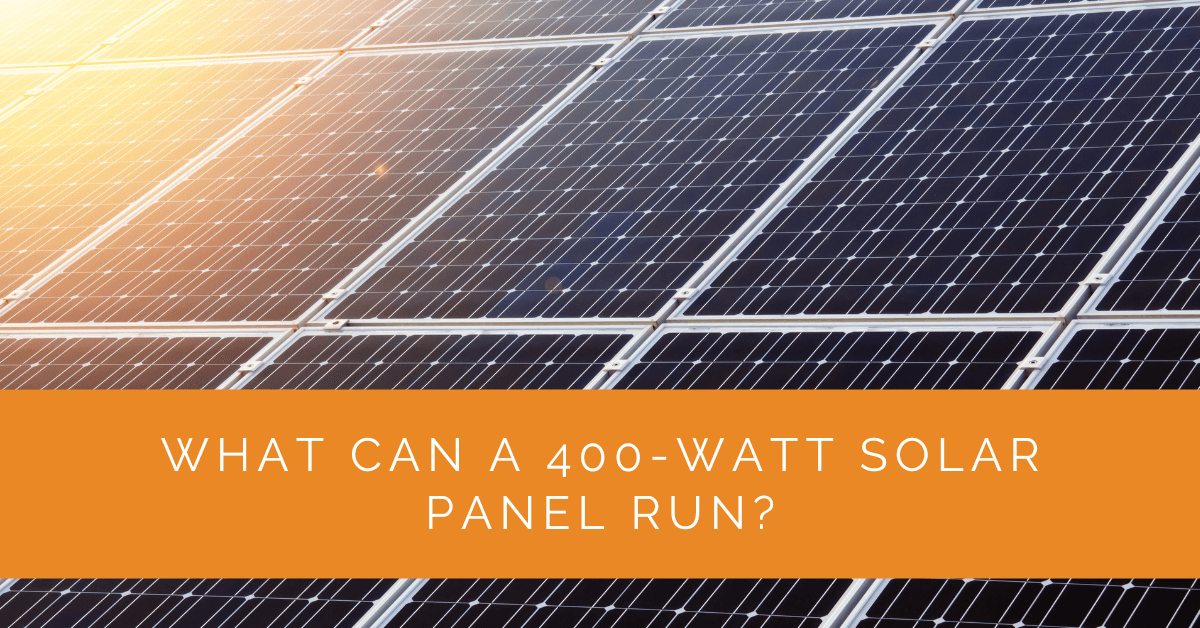Solar panels have emerged as a beacon of sustainable and eco-friendly power production in energy generation. The 400-watt solar panel shines as a versatile and practical choice among the many solar panel options available. In this educational journey, we’ll dive deep into the world of 400-watt solar panels, uncovering their potential applications, energy output, and essential considerations when integrating them into larger solar systems.
Contents
- 1 Key Takeaways
- 2 Understanding the 400-Watt Solar Panel
- 3 How Much Energy Does a 400-Watt Solar Panel Produce?
- 4 What Appliances Can a 400-Watt Solar Panel Run?
- 5 400W Solar Panel Usage Calculator
- 6 How Many Batteries Can a 400-Watt Solar Panel Support?
- 7 Can a 400-watt Solar Panel Run a Refrigerator?
- 8 Building a 400-watt Solar System
- 9 Determining How Many 400-Watt Solar Panels You Need
- 10 Exploring Other Wattage Panels and Solar Systems
- 11 Case Study: Maximizing the Potential of a 400-Watt Solar Panel System
- 12 Expert Insights From Our Solar Panel Installers About What a 400-Watt Solar Panel Can Run
- 13 Experience Solar Excellence with Us!
- 14 Conclusion
Key Takeaways
- A 400-watt solar panel exhibits versatility by powering small devices and household fixtures such as fans and lights and providing support for off-grid installations like cabins and RVs.
- Although inadequate for high-power appliances, pairing a 400-watt panel with batteries and efficient systems can enable it to run energy-efficient refrigerators and essential devices.
- Consider creating a solar system with multiple panels to make the most of a 400-watt solar panel. Account for factors like geographical location, energy requirements, and the use of energy-efficient appliances to maximize its potential for diverse energy needs.
Understanding the 400-Watt Solar Panel
A 400-watt solar panel represents a significant milestone in solar technology. These panels operate by harnessing sunlight through photovoltaic cells. These cells are engineered to convert sunlight into electricity using the photovoltaic effect, where sunlight excites electrons within semiconductor materials, creating an electric current. This process culminates in an impressive power output of 400 watts, making these panels a practical balance between size, efficiency, and utility.
How Much Energy Does a 400-Watt Solar Panel Produce?
Several critical factors, including solar irradiance, panel efficiency, and daily sunlight exposure, influence the energy production of a 400-watt solar panel. Ideally, a single 400-watt solar panel can generate approximately [insert value] kilowatt-hours of energy per day or roughly [insert value] monthly kilowatt-hours. However, real-world performance can vary due to shading, weather conditions, and panel orientation.
What Appliances Can a 400-Watt Solar Panel Run?
The versatility of a 400-watt solar panel extends across a wide spectrum of applications, making it an excellent choice for powering various devices and systems. Although it may not be suitable for high-power appliances, it shines in scenarios where energy efficiency and sustainability are paramount. Here’s a closer look at the types of appliances a 400-watt solar panel can effectively power:
Small Electronics and Gadgets
- Smartphones and Tablets: Charging your essential communication devices with a 400-watt solar panel is a breeze, ensuring you stay connected outdoors or in emergencies.
- Laptops and E-Readers: These devices can remain operational with the panel’s output, supporting remote work or leisure activities.
- LED Lights: Illuminating your surroundings with energy-efficient LED lights enhances safety and comfort during nighttime hours.
Household Devices
- Fans: Running fans for cooling or ventilation ensures indoor comfort without relying on grid power.
- Televisions: The panel can power Energy-efficient TVs, offering entertainment and information access during power outages or off-grid living.
- Small Refrigerators: While full-sized refrigerators may be impractical, compact and energy-efficient models can be powered to preserve perishable goods.
Outdoor Gear and Recreational Appliances
For outdoor enthusiasts, a 400-watt solar panel serves as a valuable companion:
- Camping Gear: Portable coolers, fans, and lights can be operated using the panel’s output, enhancing the camping experience with added convenience.
- Boats and RVs: When enjoying activities on the water or on road trips, the panel can power essential equipment, such as lights, communication devices, and entertainment systems.
Charging Stations
The consistent energy output of a 400-watt solar panel makes it an ideal solution for charging stations:
- Emergency Charging: During power outages or emergencies, the panel can power charging stations for various devices, ensuring you remain connected and informed.
- Public Spaces: Installing solar panel-powered charging stations in public areas provides an eco-friendly solution for people to charge their devices while moving.
While these examples demonstrate the diverse range of appliances a 400-watt solar panel can power, it’s essential to consider the energy consumption of individual appliances. Before connecting any device to a solar panel, check its wattage and usage time to ensure compatibility with the panel’s output. Understanding these limitations and capabilities empowers you to make informed decisions when setting up your solar-powered system, optimizing energy usage while reducing your environmental footprint.
400W Solar Panel Usage Calculator
Estimate what devices your 400W solar panel can power in a day:

How Many Batteries Can a 400-Watt Solar Panel Support?
The number of batteries a 400-watt solar panel can support depends on battery capacity and energy requirements. Integrating a battery bank into your solar setup allows you to store surplus energy generated during peak sunlight hours. This stored energy can then be tapped into during periods of lower solar activity, ensuring a continuous power supply. The number of batteries you can support will vary depending on battery capacity and the required energy storage duration.
Can a 400-watt Solar Panel Run a Refrigerator?
Running a refrigerator solely on a single 400-watt solar panel poses challenges due to a refrigerator’s relatively high energy consumption. However, with careful planning, this can be achieved. Using energy-efficient refrigerator models, leveraging battery storage, and optimizing energy consumption patterns can enable the operation of a refrigerator, ensuring the preservation of perishable items even in off-grid or emergencies.
Building a 400-watt Solar System
To maximize the potential of a 400-watt solar panel, you need to construct a comprehensive solar energy system. Here are some essential components and considerations:
Panel Arrays and Energy Storage
One strategy is to combine multiple 400-watt panels to create a larger array. This increases overall energy production capacity, allowing your system to power a wider range of appliances and devices. Pairing the panel array with an appropriately sized battery bank enables efficient energy storage, ensuring uninterrupted power, even when sunlight is scarce.
Charge Controllers and Inverters
Incorporating charge controllers helps manage energy flow between solar panels and the battery bank, preventing overcharging and prolonging battery life. Inverters play a vital role by converting the direct current (DC) generated by solar panels into alternating current (AC), which most household appliances and electronics use.

Determining How Many 400-Watt Solar Panels You Need
Calculating the optimal number of 400-watt solar panels for your energy needs requires a thorough assessment. Here’s how to go about it:
Energy Audit and Consumption Patterns
Start by conducting an energy audit to quantify your daily energy consumption. Understanding how much energy your appliances and devices require will guide you in selecting the appropriate number of panels. Continuously monitoring your energy consumption patterns will help refine these calculations over time.
Location and Solar Irradiance
Your geographical location plays a crucial role in solar energy generation. Regions with abundant sunlight will yield more energy. Consider local climate conditions, shading from nearby structures, and panel orientation to determine the number of panels needed to meet your energy goals.
Exploring Other Wattage Panels and Solar Systems
While the 400-watt solar panel offers substantial capabilities, exploring alternative panel wattages to tailor your system to your unique needs is essential.
Diverse Panel Capacities
Solar panels come in various wattages, catering to different energy requirements. Panels with capacities as low as 100 or exceeding 400 watts are available. Selecting the appropriate wattage involves balancing space availability, budget constraints, and desired energy output.
Scalability and Flexibility
For larger energy demands, scaling up your solar system by adding more panels is viable. Choosing panels with varying wattages allows you to create an optimal mix that caters to different energy requirements within your home or business.
Case Study: Maximizing the Potential of a 400-Watt Solar Panel System
Background
At Solar Panels Network USA, we are dedicated to providing tailored solar solutions that meet our clients’ diverse energy needs. This case study explores the successful implementation of a 400-watt solar panel system for a client aiming to achieve energy independence and sustainability for their off-grid cabin.
Project Overview
Our client, an outdoor enthusiast with a remote cabin, sought to reduce their reliance on traditional power sources and embrace renewable energy. The goal was to utilize a 400-watt solar panel system to power essential devices and appliances, ensuring a comfortable and eco-friendly living experience.
Implementation
Initial Assessment
We began by conducting a comprehensive energy audit to determine the client’s daily energy consumption. This involved identifying the essential devices and appliances to be powered by the solar panel system, such as LED lights, a small refrigerator, a fan, and charging stations for electronics.
System Design
Based on the assessment, we designed a solar energy system that included:
- 400-Watt Solar Panels: Chosen for their balance of efficiency and versatility, suitable for the client’s energy needs.
- Battery Bank: A set of deep-cycle batteries were selected to store surplus energy generated during peak sunlight hours, ensuring a steady power supply during low sunlight periods.
- Charge Controllers: Advanced MPPT charge controllers were integrated to regulate energy flow, preventing overcharging and optimizing battery health.
- Inverter: A high-efficiency inverter was installed to convert DC power from the solar panels to AC power, compatible with household appliances.
Installation Process
- Panel Placement: The solar panels were strategically mounted on the cabin roof to maximize sunlight exposure and minimize shading from surrounding trees.
- Wiring and Connections: Proper wiring was established to connect the panels to the charge controllers and battery bank, ensuring a seamless flow of energy. All connections were secured and tested for reliability.
- System Integration: The charge controllers and inverter were integrated with the existing electrical system to ensure efficient energy distribution to the specified devices and appliances.
Results
The 400-watt solar panel system provided the client with a reliable and sustainable energy source. The system efficiently powered the identified devices, and the battery bank ensured continuous power availability during cloudy days and nighttime. The client reported significant energy savings and a reduction in their carbon footprint, achieving their goal of energy independence for their off-grid cabin.
Summary
By leveraging the capabilities of a 400-watt solar panel system, Solar Panels Network USA successfully delivered a customized solution that met the client’s energy needs. This project demonstrated the importance of careful planning, proper system design, and integration in maximizing the potential of solar energy systems. Our commitment to sustainability and innovation ensures that our clients can fully harness the benefits of renewable energy, contributing to a greener future.
Expert Insights From Our Solar Panel Installers About What a 400-Watt Solar Panel Can Run
400-watt solar panels are highly versatile, making them perfect for running small electronics, LED lights, and even energy-efficient appliances in RVs and cabins. They’re a great choice for those looking to go off-grid or reduce their reliance on the grid.
Senior Solar Engineer
Pairing a 400-watt solar panel with a battery bank allows you to store surplus energy and use it during low sunlight periods. This setup can efficiently power devices like laptops, fans, and small refrigerators, ensuring you have a reliable energy source.
Solar Energy Consultant
Maximizing the efficiency of a 400-watt solar panel involves careful planning, including an energy audit and considering geographical factors. Properly integrating charge controllers and inverters ensures you get the most out of your solar system.
Renewable Energy Specialist
Experience Solar Excellence with Us!
Trust in Solar Panels Network USA, where our seasoned experts deliver top-quality solar solutions for homes and businesses nationwide. With a legacy of countless successful installations and a commitment to sustainable energy, we’re your reliable partner in the solar journey. Ready for a brighter, eco-friendly future? Call us now at (855) 427-0058 and harness the power of the sun!
Conclusion
The 400-watt solar panel stands as a technological marvel, offering a blend of efficiency and adaptability. Its modest size, substantial capacity to power devices, compatibility with off-grid living, and potential to contribute to a comprehensive solar energy system make it an invaluable asset. By incorporating energy storage solutions, optimizing consumption patterns, and considering factors like location and energy demand, you can unleash the full potential of the 400-watt solar panel to create a sustainable and dependable energy source tailored to your unique requirements.
About the Author
Solar Panels Network USA stands at the forefront of solar energy solutions, driven by a team of seasoned solar engineers and energy consultants. With over decades of experience in delivering high-quality solar installations and maintenance, we are committed to promoting sustainable energy through customer-centric, tailored solutions. Our articles reflect this commitment, crafted collaboratively by experts to provide accurate, up-to-date insights into solar technology, ensuring our readers are well-informed and empowered in their solar energy decisions.

